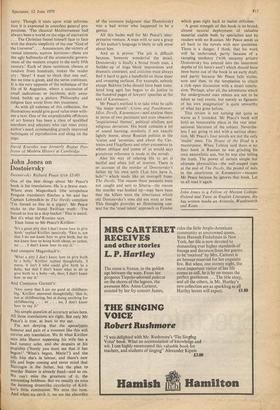David Knowles on Rome after Marcus Aurelius
The World of Late Antiquity Peter Brown (Thames and Hudson £2.00) The World of Late Antiquity Peter Brown (Thames and Hudson £2.00)
Late Antiquity, the name given to the age between AD 180 and 500, was for long an
interlunary period for historians and readers alike. Classical scholars ceased to be interes- ted after MarcuS Aurelius, and European historians began with monks and the papacy around, the time of Gregory the Great. The vast exception of Gibbon only proved the rule. He was applauded and read, but the void remained.
Recently the forgotten age has come under review. Partly, it may be, because we think to see kinship in the twilight of a great civil- isation; partly because, in the general dis- taste for lessons from history, we appreciate an age which seems to provide none; partly because the new discipline of art history has done much to illuminate a time when great literature was rare. A. Momigliano and A. H. NI. Jones in this country, and H. I. Marrou in France. have brought the scene from the scholar to the consciousness of the general reader, and Peter Brown has recently made an unfamiliar corner luminous in his biography of Augustine.
It is he who now interprets these cen- turies for the Thames and Hudson series, and he is in many ways the most complete Eng- lish historian for the task. His knowledge of the western part of the Roman empire in the third and fourth centuries is wide and detailed, and he can. range earlier and later. He does not look at the period as merely a decline from the grandeur that was Rome, or as the stamping ground of a group of founders of the middle ages. He makes a significant point in contrasting the two con- structive epochs of provincial imperial society in the west. There is the age of the legists and of bourgeois display, when city councillors and administrators built fora. baths and amenities of all kinds from Britain to the Sahara; and there is the age of the cultured rural landowners of 380-450. .wealthy men, ready to carry on provincial government but with no sense of the needs of the time fOr strong and united effort. These men, some of them wholly pagan. others Christian and even bishops, tolerant of classical literature and unfriendly to- wards the new monasticism that was creep- ing round the Mediterranean. lived grandly in the St Martin's summer of the ancient world, the afterglow of a warm sunset.
There is a great deal of learning and reflec- tion in this detailed and polished account. The trouble for the careful reader is that there is more in it than the mind can well
carry. Though it rests upon wide informa- tion it is expressed in countless general pro- positions. 'The classical Mediterranean had always been a world on the edge of starvation . .. The Christian found himself face to face with the drastic simplicity of the one "God of the Universe".... Amateurism, the victory of vested interests, narrow horizons—these are the ugly hallmarks of the aristocratic govern- ment of the western empire in the early fifth century.' Each of these sentences, chosen at random from hundreds, makes the reader cry : 'Stop! 1 want to think that one out', but no time is given, and the series continues. It is the very opposite of the technique of the life of St Augustine, where a succession of small indications or incidents, duly anno• tated, builds up a picture. Philosophy and religion fare worst from this treatment.
As with all volumes of this collection, the illustrations would give good value even with- out a text. One of the unpredictable offshoots of art history has been a class of qualified searchers and selectors who can meet every author's need, commanding greatly improved techniques of reproduction and siting on the page.
David Knowles was formerly Regius Pro- fessor of Modern History of Cambridge



































 Previous page
Previous page